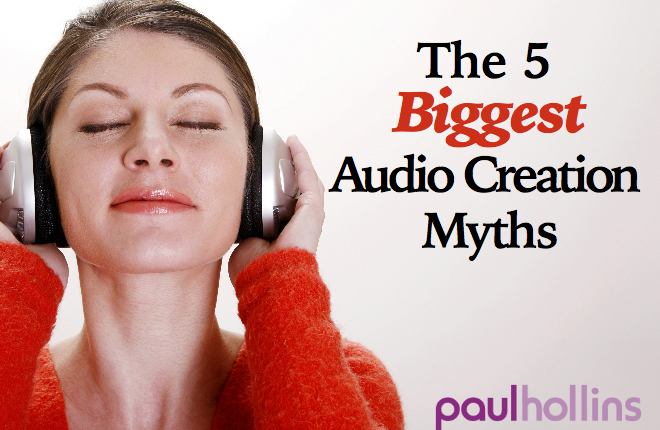How do you start making audio products?
Well first, lets dispel the 5 biggest myths.
Myth #1. You Need Lots of Equipment
10 years ago you would’ve probably needed a degree in audio science if you wanted to create professional quality audio products at home.
But these days you can easily produce professional quality content with just a few key components:
• A home computer
• A USB microphone (or headset)
• An internet connection
I’m going to take a wild guess at this point and assume you’ve already got a computer and an internet connection.
So the chances are that all you’ll need is a microphone. But which one?
My current recommendation is the Rode NT-USB microphone which is an amazing semi-professional microphone (it’s the one I now use).
It connects via USB – and that’s what we’re looking for in order to ensure you get the ultimate sound fidelity.
With a USB microphone you’re well on your way to creating professional quality audio products.
Myth #2. You Need Expensive (And Difficult To Learn) Software
If you’ve got money burning a hole in your pocket, then why not splash out on some super-expensive audio editing software? There’s plenty to choose from such as Pro-Tools, Cakewalk, WaveLab.
But for everyone else there’s Audacity.
Audacity is a feature-rich yet totally FREE audio editing suite that runs on both the PC and Mac.
You can download it from www.paulhollins.com/audacity
The great thing about Audacity is that it’s very straight-forward and relatively intuitive to learn. In fact, it’s so easy you can probably master it with just a couple of hours of practice.
However if you do get stuck you’ll find a whole raft of video to help you on You Tube. Simply search for ‘Audacity’ and there’s bound to be someone who’s posted a video that will help solve your problem.
Myth #3. You Need A Soundproof Studio
As long as you have a quiet place to record your audio, then full soundproofing isn’t necessary. So don’t worry you won’t have to stick empty egg-boxes on to your wall or anything crazy like that.
If you’re using a headset microphone like the Plantronics DSP655 then you shouldn’t encounter too many problems with room noise (or echo/reverb as it’s sometimes called) as the mic is positioned so near to your mouth that echo simply isn’t noticeable.
Just try not to breathe directly onto the mic or you may suffer from wind noise (I mean that in the audio sense… you understand). :-)
If however you’re using a “proper” microphone such as the Rode NT-USB, you may notice that it may be prone to sound reflections from around the room.
It’s a problem that’s not too hard to fix and it certainly doesn’t have to be expensive.
In fact any room that has carpets, curtains and, say, a sofa/bed would make a perfect environment for a ‘recording area’ because soft furnishings tend to absorb the majority of sound reflections.
If you only have an area with wooden floors and no soft furnishings, then there are things you can do to help ‘deaden’ the sound and absorb these unwanted reflections.
A rug on the floor and a duvet around the back of the microphone are an affordable & effective way of soaking up much of these unwanted sounds.
Also try to position yourself so that there is something absorbent behind you, like a pair of thick drapes… or failing that a duvet propped against the wall (or you could even hang some thick coats/jackets behind you too).
It won’t soundproof the room, but it will help deaden the reflections and make your recordings sound much better.
Myth #4. I’d Never Think Of Anything To Say
This is one of the worries that most people have.
However if you can talk confidently about your niche or if you can ask an expert some questions about your niche, then you can make an audio product… no question!
Use bullet-points or some pre-written notes to use as prompts and you won’t go far wrong.
Myth #5. Audio Is Difficult To Distribute
This is probably the easiest myth to dispel.
Most PCs come with a built-in CD/DVD writer, so it’s super-easy to make a CD of your audio product.
I know you might be thinking that CD is a very old-skool format and that things have ‘moved on’, and while that is partly correct, don’t underestimate the power CDs have for product creators like us.
CDs are still an ideal medium despite the shift towards mp3 downloads in more recent times.
My reason for saying that is because most people still have a CD player at home or in their car.
CDs also tend to have a higher perceived value than mp3s simply because it’s a physical product that your clients can see, feel and touch (as well as scratch & lose!). :-)
MP3 downloads are also ideal, but don’t forget that you can also stream your audio product via a simple player on your website too.
In Conclusion
So as you can see there are plenty of ways to distribute your finished product. You could even add it to iTunes, the world’s largest audio search-engine.
So now we’ve dispelled the 5 biggest myths why not get started creating your own audio programs.


Some great ideas Paul as my “Studio” (spare bedroom) just has painted walls. I’m off to download Audacity now.
Thanks for the feedback Chris… and good luck with turning your spare bedroom into a full-on studio. :)